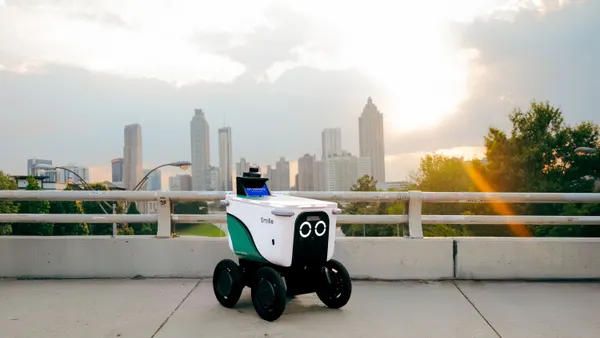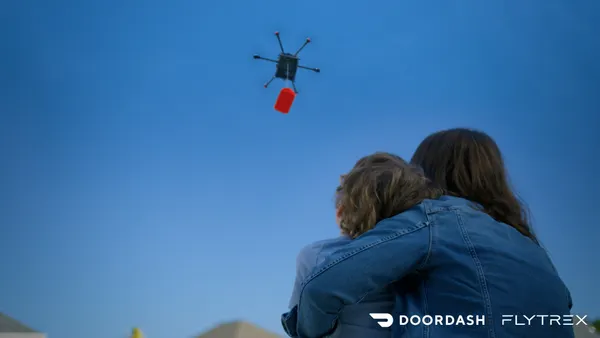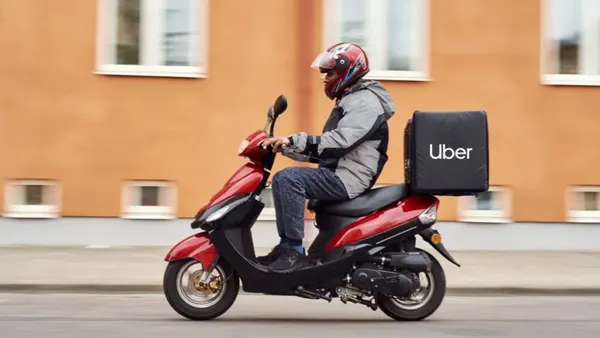Technology is a linchpin for the modern restaurant's success, reflected by industry investments in smart drive-thrus, back-of-house robotics and hyper-convenient mobile app and website interfaces. And while these digital trends are set to crystallize and offer continued growth opportunity in 2020, the National Restaurant Association predicts they could also usher in major disruption in 2030.
"The basic paradigm of what you call restaurants in America today is rapidly changing," Hudson Rhiele, SVP of the National Restaurant Association, told Restaurant Dive.
The majority of this industry shift is driven by diner demand for off-premise eating occasions, he said. More than 60% of the restaurant market's traffic is driven by delivery, curbside pickup, food trucks and other occasions beyond traditional dine-in, a path to growth that will be even more key to survival in the coming decades, Rhiele said.
"Technology will have a truly transformational impact [in 2030] ... whether it's in terms of ordering, dynamic pricing or how consumers are directed through drive-thrus," he said.
In the NRA's Restaurant Industry 2030 report, a team of futurists from Foresight Alliance developed a list of "disruptors" that could face the restaurant space in the next decade. Seven of the ten focus areas are rooted in digital and operational technology — "possible futures, based on external factors such as demographic trends and artificial intelligence," per the report.
And though these changes could pose costly challenges to the restaurant chain of tomorrow, they also provide new occasions for differentiation.
"The restaurant industry future is solidly optimistic, with new opportunities that couldn't have existed in the previous 10 [to] 20 years," Rhiele said. "It doesn't mean that consumers will be using new technology all the time, but it does mean the typical restaurant occasion will change in terms of how food is ordered, paid for, prepped, served and delivered."
Here are the report's predictions of how technology will disrupt the 2030 landscape, from back-of-house to in-app offerings.
The intelligent, bionic restaurant will reduce reliance on labor
The report claims that near-universal smartphone adoption and consumer ease with AI assistants like Apple's Siri and Amazon's Alexa will drive restaurants to hinge their operations in information technology to meet demand for dynamic, responsive data.
This could include menus that adjust pricing in real-time to accommodate supply and demand fluctuations, as well as in-depth supply chain authentication. It will be important for restaurants to embrace AI as both a connective marketing tool and a functional building block, the report suggests, because AI will soon serve as a "personal assistant and gatekeeper between brand and consumer."
Restaurants can insert themselves into this relationship by adding physical objects embedded with software that can receive and share data, such as Chick-fil-A's tableside ordering sensors. Voice search is also predicted to be an integral component of the consumer journey in the near future, and the report posits that more brands will advertise on virtual assistant platforms, which could be "highly responsive to small tweaks in restaurant pricing or other data."
Automation will also transform back-of-house robotics, which Foresight's futurists believe will be more sophisticated and reprogrammable than what's available in today's market. This could include operations as advanced as re-creating the specific movements of chefs in the kitchen with machinery through motion capture, and this kitchen technology could relieve human workers of repetitive food preparation tasks.
"When technology is integrated and applied to the industry, it can have extraordinary productivity and efficiency gains," Rhiele said. "Fifteen million individuals are employed in the restaurant industry, or one out of every 10 Americans, because the industry is so labor intensive."
This type of technology isn't expected to completely replace workers in back-of-house, however. This machinery will be designed for human intervention, and chefs will work alongside these systems to ensure that operations run smoothly. As a result, restaurants that are able to invest in this kind of model will be able to reduce their reliance on human labor, maximize productivity and ensure consistent food quality, per the report, though capital costs will increase.
Still, these systems will require a different kind of training for employees, who will need to know how to work alongside this smart technology in the day-to-day kitchen workflow. By 2030, NRA also predicts that AI could be programmed with knowledge of cooking techniques, food chemistry and recipes to create new food and beverage offerings, especially ones tailored to specific diner preferences or dietary needs.
As more brands go virtual, rival apps will pose greater threats
Restaurant brands and third-party delivery platforms are already experimenting with ghost kitchens as demand for delivery and real estate prices climb, and Rhiele predicts that this new model will allow new restaurant chains to launch quickly at both a regional and national level — and crowd an already saturated space.
"The industry now has more than 1 million restaurant locations and on a net basis that increases by about 1.5% per year," Rhiele said. "So in a typical year, about 60,000 new restaurants open."
Restaurants will need to develop more robust social media strategies and online branding to stand out among a more crowded digital delivery space, especially as more digitally native diners come into their full purchasing power, he said.
This shift will also force brands to define what it means to be a restaurant when a concept isn't anchored by a brick-and-mortar space or interactions between store staff and consumers. Ostensibly, money saved by nixing front-of-house retail space for either a kitchen-only location or a place in a shared commissary kitchen could be poured into marketing campaigns meant to answer that question for individual brands. These extra funds could also give restaurants the financial flexibility to launch surprise "pop-up" locations in different markets to create a sense of excitement around a brand and test performance with varying demographics, according to the report.
Establishing a strong brand identity for a virtual restaurant won't just be competitive in 2030, however, it will be key to survival as diners grow more loyal to third-party apps. Aggregators will increasingly serve as gatekeepers between diners and restaurants thanks to the variety of brands that they house — including concepts they develop, like Uber Eats' Rachael Ray-branded restaurant — and the frictionless ordering experience they offer.
Still, this landscape may offer independent restaurants a leg up by bypassing expensive startup costs and getting in front of the digital diner right away. But this low barrier to entry means that restaurants will also need to fine-tune their menu offerings to reflect unique market demands and current trends if they hope to stand out, according to the report.
Autonomous vehicles will transform the drive-thru
Major restaurant chains are already overhauling their drive-thru systems to accommodate future diner trends, with McDonald’s and Sonic outfitting their digital menu boards with AI to offer predictive, personalized offerings for customers, and Chipotle rolling out "Chipotlane" pickup lanes exclusively for online orders.
These investments could spark a sea change in off-premise investment next year, but in 2030 the drive-thru will need to adapt to the rise of autonomous vehicles as well.
"It is entirely plausible to envision autonomous vehicles at different points of access delivering restaurant-prepared meals ... in major metropolitan areas," Rhiele said. "The extrapolation of that is having autonomous vehicles directed to different drive-thru lanes at quick-service restaurants."
With autonomous vehicles, drivers will be able to eat and drink in their cars with both hands, a benefit for QSRs and fast casual brands, per the report. But restaurants will also be responsible for developing drive-thru systems that feature appropriate safety technology and risk control that will accommodate for self-driving cars and autonomous delivery vehicles.
For example, the NRA 2030 report predicts that AI-backed voice assistants will eventually interface with smart vehicles directly. Because of this, it will be important for restaurants to develop robust marketing that includes campaigns featured on screens in autonomous vehicles. Hands-free driving will also give restaurants the opportunity to market foods at the drive-thru that would be too challenging to eat while driving a standard car.
As diners continue to shift their spending to the away-from-home market, off-premise restaurant channels will continue to develop and expand, Rhiele said. And though off-premise assets like new drive-thru technologies are costly today, he believes they will become more affordable for major and mid-sized chains in the coming years.
"Like with any technology, the economies of scale kick into play. And so the unit costs of that technology drops financially," he said. So what currently may be extremely capital investments for larger organizations, as month and years [go] past, really [will] become more available to the general market."













